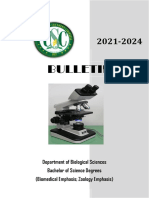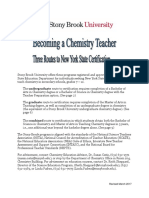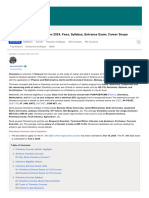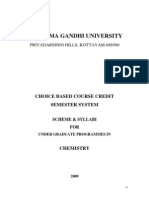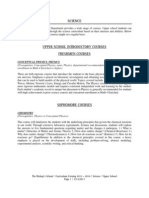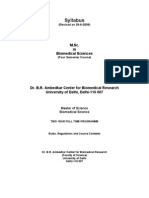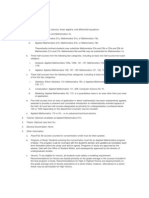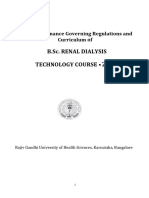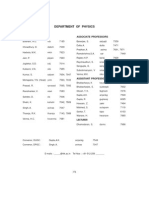CHEMistry
CHEMistry
Uploaded by
Federico LeonCopyright:
Available Formats
CHEMistry
CHEMistry
Uploaded by
Federico LeonCopyright
Available Formats
Share this document
Did you find this document useful?
Is this content inappropriate?
Copyright:
Available Formats
CHEMistry
CHEMistry
Uploaded by
Federico LeonCopyright:
Available Formats
Chemistry
Departmental Counselor: Gregory Hillhouse, GCIS E419B, 702-7057, gh15@uchicago.edu Web: chemistry.uchicago.edu
Program of Study
Chemistry is concerned with the preparation, composition, and structure of matter and with the equilibrium and kinetic laws that govern its transformations. The B.A. and B.S. degrees in chemistry are designed to provide a broad foundation in the three principal branches of the science: inorganic, organic, and physical chemistry. Analytical chemistry, often regarded as an independent branch, is incorporated into the program. Both curricula discuss experimental and theoretical work and emphasize their interdependence. Both degree programs prepare the student for a career in chemistry. However, the B.S. degree offers a more intensive program of study. The B.A. degree also offers thorough study in the field of chemistry, but it provides a wide opportunity for elective freedom and for the pursuit of interdisciplinary interests in areas such as biochemistry, biophysics, chemical physics, geochemistry, premedicine, and education.
Program Requirements
The principal distinction between the B.A. and B.S. programs is the number of chemistry courses required. Program Requirements: B.A. A minimum of eight courses in chemistry beyond the general education requirement (which should be taken in the first year) is required for the B.A. degree. Program Requirements: B.S. A minimum of twelve courses in chemistry beyond the general education requirement (which should be taken in the first year) is typically required for the B.S. degree.
Chemistry (pscd) 115 Summary of Requirements
General Education Major CHEM 11101-11201 or 11102-11202 or equivalent* MATH 15100-15200 or 16100-16200, or a grade of Aor higher in 13100-13200 1 1 2 3 CHEM 11301 or 11302 or equivalent* MATH 15300 or 16300 or 19620, or a grade of A- or higher in 13300 MATH 20000-20100 PHYS 13100-13200-13300 or higher
plus the following requirements: B.A. 1 CHEM 20100 3 CHEM 22000-22100-22200/ 23000-23100-23200 2 CHEM 26100-26200 1 CHEM 26700 14 B.S. 2 CHEM 20100-20200 3 CHEM 22000-22100-22200/ 23000-23100-23200 1 CHEM 23300 3 CHEM 26100-26200-26300 1 CHEM 26700 1 CHEM 22700 or 26800 18
Credit may be granted by examination. * See following sections on Advanced Placement and Honors Chemistry Placement Test.
NOTE: The three-quarter sequence MATH 20300-20400-20500 may be substituted for 20000; and MATH 27000 and 27300 may be substituted for 20100. MATH 19620 is recommended for chemistry majors who plan to pursue advanced study in physical chemistry. Advanced Placement. Students who earned a score of 5 on the AP test in chemistry are given credit for General Chemistry I, II, III. Many such students elect to take Honors General Chemistry (CHEM 12100-12200-12300). Students who complete one to three quarters of General Chemistry or Honors General Chemistry forgo partial or full AP credit. Honors Chemistry Placement Test. Other students who have successfully completed a rigorous chemistry course in high school may enroll in Honors General Chemistry (CHEM 12100-12200-12300) with adequate performance on the Honors Chemistry Placement Test that is offered to entering students during Orientation.
116 Chemistry (pscd)
Accreditation. The Department of Chemistry also administers accreditation examinations for General Chemistry I, II, III and Organic Chemistry I, II, III to entering college students. Only incoming first-year and transfer students are eligible to take these examinations, which are offered at the beginning of Autumn Quarter. Students may receive credit on the basis of their performance on accreditation examinations. Grading. In order to qualify for the B.A. or B.S. degree, a GPA of 2.0 or higher (with no grade lower than C-) is needed in required chemistry courses. Students majoring in chemistry must receive quality grades in all courses required in the degree program. Nonmajors may take chemistry courses on a P/F basis; only grades of C- or higher constitute passing work. Undergraduate Research and Honors. By their third year, students majoring in chemistry are strongly encouraged to participate in research with a faculty member. For more information on research opportunities, visit chemistry.uchicago. edu/undergrad.shtml. Excellent students who pursue a substantive research project with a faculty member of the Department of Chemistry should plan to submit an honors thesis based on their work. Students usually begin this research program during their third year and continue through the following summer and their fourth year. Students who wish to be considered for honors are expected to complete their arrangements with the departmental counselor before the end of their third year and to register for one quarter of CHEM 29900 (Advanced Research in Chemistry) during their third or fourth years. To be eligible to receive honors, students in the B.A. or B.S. degree program in chemistry must write a creditable honors paper describing their research. The paper must be submitted before the deadline established by the departmental counselor and must be approved by the Department of Chemistry. In addition, an oral presentation of the research is required. The research paper or project used to meet this requirement may not be used to meet the B.A. paper or project requirement in another major. To earn a B.A. or B.S. degree with honors in chemistry, students must also have an overall GPA of 3.0 or higher. Sample Program. A suggested schedule for completing a B.A. or B.S. degree in chemistry follows. First year Second year CHEM 11101-11201-11301/11102-11202-11302 or 12100-12200-12300 MATH 15100-15200-15300 or 19620 or equivalent CHEM 22000-22100-22200 or CHEM 23000-2310023200 MATH 20000-20100
Chemistry (pscd) 117
Third year Fourth year Physics sequence (three quarters) CHEM 26100-26200-26700 (if physics is taken in the second year) CHEM 20100 CHEM 20200, 23300 or 26300 (for B.S.) CHEM 26100-26200-26700 (if physics is taken in the third year) CHEM 23300 or 26300 (for B.S.) CHEM 22700 or 26800 (for B.S.)
Joint Degree Programs. Students who achieve advanced standing through their performance on placement examinations or accreditation examinations may consider the formulation of a four-year degree program that leads to the concurrent award of the B.S. and M.S. degrees in chemistry. Consult the departmental counselor for more information.
Faculty
R. S. Berry, B. Bosnich, L. Butler, R. N. Clayton, A. Dinner, P. E. Eaton, G. Engel, K. Freed, P. Guyot-Sionnest, J. Halpern, R. Haselkorn, C. He, G. Hillhouse, M. Hopkins, R. Ismagilov, R. Jordan, S. Kent, S. Kozmin, K. Y. C. Lee, D. H. Levy, J. C. Light, D. Mazziotti, M. Mrksich, J. R. Norris, Jr., T. Oka, J. Piccirilli, V. Rawal, S. A. Rice, N. F. Scherer, S. Sibener, H. Yamamoto, N. C. Yang, J. Yin, L. Yu
Courses: Chemistry (chem)
In chemistry labs, safety goggles must be worn at all times. Students who require prescriptive lenses may wear prescription glasses under goggles; contact lenses may not beworn. Exceptions for medical reasons must be obtained from the lab director. 11101-11201-11301/11102-11202-11302. General Chemistry I, II, III (Variant A/Variant B). PQ: Good performance on the mathematics or calculus placement test. The first two courses in this sequence meet the general education requirement in the physical sciences. Variants A and B are equivalent in the first and second quarters but differ in focus in the third quarter as detailed below. Both three-quarter sequences cover atomic and molecular theories, chemical periodicity, chemical reactivity and bonding, chemical equilibria, acid-base equilibria, solubility equilibria, phase equilibria, thermodynamics, electrochemistry, kinetics, and nuclear chemistry. Examples are drawn from chemical, biological, and material systems. The laboratory portion includes an introduction to quantitative measurements, investigation of the properties of the important elements and their compounds, and experiments associated with the common ions and their separation and identification. 11101-11201-11301. General Chemistry I, II, III (Variant A). (=ENST 11101-11201-11301) PQ: Good performance on the mathematics or calculus
118 Chemistry (pscd)
placement test. The first two courses in this sequence meet the general education requirement in the physical sciences. Variant A is presented at the same level as Variant B, but the material in the third quarter is presented from a more synthetic perspective. Autumn, Winter, Spring. L: M. Zhao, K. Y. Lee, Autumn; A. Dinner, Winter; Staff, Spring. 11102-11202-11302. General Chemistry I, II, III (Variant B). PQ: Good performance on the mathematics or calculus placement test. The first two courses in this sequence meet the general education requirement in the physical sciences. Variant B is presented at the same level as Variant A, but the material in the third quarter is presented from a more physical perspective. Autumn, Winter, Spring. L: M. Zhao, D. Mazziotti, Autumn; P. Guyot-Sionnest, Winter; L. Butler, Spring. 12100-12200-12300. General Chemistry I, II, III (Honors). PQ: Good performance on the honors chemistry placement test or a score of 5 on the AP chemistry test. The first two courses in this sequence meet the general education requirement in the physical sciences. The subject matter and general program of this sequence is similar to that of General Chemistry listed previously. However, this accelerated course on the subject matter is designed for students deemed well prepared for a thorough and systematic study of chemistry. Introductory materials covered in the General Chemistry sequence is not part of the curriculum for this Honors sequence; instead, special topics are included in each quarter to provide an indepth examination of various subjects of current interest in chemistry. Autumn, Winter. L: M. Zhao, S. Sibener, Autumn; N. Scherer, Winter; Staff, Spring. 20100-20200. Inorganic Chemistry I, II. PQ for 20100: CHEM 1110111201-11301 or equivalent, 22000 and 22100, or concurrent enrollment in 22100 or equivalent. PQ for 20200: CHEM 20100 and 22200. The extraordinarily diverse chemistry of the elements is organized in terms of molecular structure, electronic properties, and chemical reactivity. CHEM 20100 concentrates on structure and bonding, solid state chemistry, and selected topics in the chemistry of the main group elements and coordination chemistry. CHEM 20200 focuses on organometallic chemistry, reactions, synthesis, and catalysis, as well as bioinorganic chemistry. G. Hillhouse, Winter; R. Jordan, Spring. 22000-22100-22200. Organic Chemistry I, II, III. PQ: An average grade of C or higher in CHEM 11101-11201-11301 or CHEM 12100-12200-12300, or consent of the department. (Students who receive a grade of B+ or higher in CHEM 22000 have the option of moving into honors organic chemistry for Winter/Spring. See following listing for CHEM 23100-23200.) NOTE: Most medical schools require a full academic year of organic chemistry. The fundamental structures of organic molecules and the spectroscopic methods used to define them are studied. A comprehensive understanding of the reactions and properties of organic molecules (from kinetic, thermodynamic, and mechanistic viewpoints) is developed and applied to the synthesis of organic compounds and to an appreciation of natures
Chemistry (pscd) 119
important molecules. A lab is one afternoon a week in addition to scheduled class time each quarter. Autumn, Winter, Spring. L: V. Keller. Autumn, Winter, Spring. 22700. Advanced Organic/Inorganic Laboratory. PQ: CHEM 20100 and 23300, or consent of instructor. A project approach is combined with exposure to the more advanced techniques of organic and inorganic chemistry. Multistep synthesis, the synthesis of air-sensitive compounds, advanced chromatographic and spectroscopic characterization of products, and the handling of reactive intermediates are a part of the lab. Spring. 23000-23100-23200. Honors Organic Chemistry I, II, III. PQ: A grade of B or higher in CHEM 11101-11201-11301 or CHEM 12100-12200-12300, a 5 on the AP Chemistry exam, or consent of the department. Students who have taken CHEM 22000 or 22100 with an average grade of B+ or higher may petition the instructor to move into the Honors sequence. NOTE: Most medical schools require a full academic year of organic chemistry. The fundamental structures of organic molecules and the spectroscopic methods used to define them are studied. A comprehensive understanding of the reactions and properties of organic molecules (from kinetic, thermodynamic, and mechanistic viewpoints) is developed and applied to the synthesis of organic compounds and to an appreciation of natures important molecules. A lab is one afternoon a week in addition to scheduled class time each quarter. Autumn, Winter, Spring. L: V. Keller. Autumn, Winter, Spring. 23300. Intermediate Organic Chemistry: Biological Chemistry. PQ: A grade of C or higher in CHEM 22200 or 23200, or consent of instructor. This course addresses the chemical foundations of the biosynthetic pathways for amino acids, carbohydrates, lipids, and natural products. We emphasize reaction mechanisms in the biosynthesis of these naturally occurring molecules. Autumn. 26100-26200-26300. Physical Chemistry I, II, III. PQ: CHEM 11301 or equivalent; MATH 20100 and PHYS 13300. The application of physical and mathematical methods to the investigation of chemical systems is studied during this three-quarter sequence. 26100. Quantum Mechanics. This course presents quantum mechanics, the Schrdinger wave equation with exact and approximate methods of solution, angular momentum, and atomic spectra and structure. L. Butler. Autumn. 26200. Thermodynamics. This course continues the sequence with the study of thermodynamic principles and applications, as well as statistical mechanics. K. Y. Lee. Winter. 26300. Chemical Kinetics and Dynamics. This course is a discussion of chemical kinetics and dynamics for processes in gases, in liquids, and at interfaces. S. Sibener. Spring. 26700. Experimental Physical Chemistry. PQ: CHEM 26100. This course introduces the principles and practice of physical chemical measurements.
120 Chemistry (pscd)
Techniques used in the design and construction of apparatus are discussed in lectures, and practice is provided through lab exercises and experiments. Subjects covered include vacuum techniques, electronics, optics, use of computers in lab instrumentation, materials of construction, and data analysis. J. Norris. Winter. L. 26800. Computational Chemistry and Biology. PQ: CHEM 26100-26200, or PHYS 19700 and 23400. The theme for this course is the identification of scientific goals that computation can assist in achieving. We examine problems such as understanding the electronic structure and bonding in molecules, interpreting the structure and thermodynamic properties of liquids, protein folding, enzyme catalysis, and bioinformatics. The lectures deal with aspects of numerical analysis and with the theoretical background relevant to calculations of the geometric and electronic structure of molecules, molecular mechanics, molecular dynamics, and Monte Carlo simulations. The lab consists of computational problems drawn from a broad range of chemical and biological interests. K. Freed. Spring. L. 29900. Advanced Research in Chemistry. PQ: Consent of a faculty sponsor and the undergraduate counselor. Open only to students majoring in chemistry who are eligible for honors. Available for either quality grades or for P/F grading. Students are required to submit the College Reading and Research Course Form. Students conduct advanced, individually guided research. Students may submit a written report covering their research activities for consideration for departmental honors. Summer, Autumn, Winter, Spring. 30100. Advanced Inorganic Chemistry. PQ: CHEM 20100 and 26300, or consent of instructor. Group theory and its applications in inorganic chemistry are developed. These concepts are used in surveying the chemistry of inorganic compounds from the standpoint of quantum chemistry, chemical bonding principles, and the relationship between structure and reactivity. M. Hopkins. Autumn. 30200. Synthesis and Physical Methods in Inorganic Chemistry. PQ: CHEM 30100. This course covers theoretical and practical aspects of important physical methods for the characterization of inorganic molecules. Topics may include NMR, IR, RAMAN, EPR, and electronic and photoelectron spectroscopy; electrochemical methods; and single-crystal X-ray diffraction. R. Jordan. Winter. 30400. Organometallic Chemistry. PQ: CHEM 20100. The preparation and properties of organometallic compounds (notably those of the transition elements, their reactions, and the concepts of homogeneous catalysis) are discussed. G. Hillhouse. Winter. 30500. Nanoscale Materials. PQ: CHEM 20200 and 26300, or consent of instructor. This course provides an overview of nanoscale phenomena in metals, semiconductors, and magnetic materials (e.g., the fundamental aspects of quantum confinement in semiconductors and metals, superparamagnetism in
Chemistry (pscd) 121
nanoscale magnets, electronic properties of nanowires and carbon nanotubes, surface plasmon resonances in nanomaterials, photonic crystals). Special attention is paid to preparative aspects of nanomaterials, colloidal and gas-phase syntheses of nanoparticles, nanowires, and nanotubes. Engineered nanomaterials and their assemblies are considered promising candidates for a variety of applications, from solar cells, electronic circuits, light-emitting devices, and data storage to catalysts, biological tags, cancer treatments, and drug delivery. The course covers state-of-the art in these and other areas. Finally, the course provides an overview of the experimental techniques used for structural characterization of inorganic nanomaterials (e.g., electron microscopy, X-ray diffractometry, small-angle X-ray scattering, STM, AFM, Raman spectroscopy). D. Talapin. Autumn. 30600. Chemistry of the Elements. PQ: CHEM 20100. The descriptive chemistries of the main-group elements and the transition metals are surveyed from a synthetic perspective, and reaction chemistry of inorganic molecules is systematically developed. C. He. Spring. 30900. Bioinorganic Chemistry. PQ: CHEM 20200 and 22200/23200. This course covers various roles of metals in biology. Topics include coordination chemistry of bioinorganic units, substrate binding and activation, electrontransfer proteins, atom and group transfer chemistry, metal homeostasis, ion channels, metals in medicine, and model systems. C. He. Autumn. 31100. Supramolecular Chemistry. This course develops the concepts of supramolecular chemistry (both organic and metal-based systems) and its applications. Coordination chemistry is introduced as a background to metalbased supramolecular systems. The chemistry and physical properties of transition metal complexes are presented, including crystal field theory, molecular orbital theory, magnetism, and electronic spectra. The mechanisms by which molecular motors operate are presented and reference is made to synthetic systems that attempt to emulate biological molecular motors. Spring. 32100. Physical Organic Chemistry I. PQ: CHEM 22200/23200 and 26200, or consent of instructor. We focus on the quantitative aspects of structure and reactivity, molecular orbital theory, and the insight it provides into structures and properties of molecules, stereochemistry, thermochemistry, kinetics, substituent and isotope effects, and pericyclic reactions. L. Yu. Autumn. 32200. Organic Synthesis and Structure. PQ: CHEM 22200/23200 or consent of instructor. This course considers the mechanisms, applicability, and limitations of the major reactions in organic chemistry, as well as of stereochemical control in synthesis. V. Rawal. Autumn. 32300. Tactics of Organic Synthesis. PQ: CHEM 22200/23200 or consent of instructor. This course discusses the important classes for organic transformation. Topics include carbon-carbon bond formation; oxidation; and reduction using a
122 Chemistry (pscd)
metal, non-metal, or acid-base catalyst. We also cover design of the reagents and the scope and limitation of the processes. H. Yamamoto. Winter. 32400. Physical Organic Chemistry II. PQ: CHEM 32100. Topics include the mechanisms and fundamental theories of free radicals and the related free radical reactions, biradical and carbene chemistry, and pericyclic and photochemical reactions. S. Kozmin. Winter. 32500. Bioorganic Chemistry. A goal of this course is to relate chemical phenomena with biological activities. We cover two main areas: (1) chemical modifications of biological macromolecules and their potential effects; and (2) the application of spectroscopic methods to elucidate the structure and dynamics of biologically relevant molecules. J. Yin. Spring. 32600. Protein Fundamentals. (=BCMB 30400) PQ: BCMB 30100 or consent of instructor. The focus of this course is on the physico-chemical phenomena that define protein structure and function. Topics include (1) the interactions/forces that define polypeptide conformation; (2) the principles of protein folding, structure, and design; and (3) the concepts of molecular recognition and enzyme catalysts. J. Piccirilli. Autumn. 32900. Polymer Chemistry. PQ: CHEM 22200/23200 and 26300. This course introduces a broad range of polymerization reactions and discusses their mechanisms and kinetics. New concepts of polymerization and new materials of current interest are introduced and discussed. We also discuss the physical properties of polymers, ranging from thermal properties to electrical and optical properties in both a solution state and a solid state. Our emphasis is on structure/ property relationship. Spring. 33000. Complex Chemical Systems. PQ: CHEM 22200/23200 and MATH 20100, or consent of instructor. This course describes chemical systems in which nonlinear kinetics lead to unexpected (emergent) behavior of the system. Autocatalytic and spatiotemporal pattern forming systems are covered, and their roles in the development and function of living systems are discussed. Spring. 33100. New Synthetic Reactions and Catalysts. PQ: CHEM 23300. This course presents recent highlights of new synthetic reactions and catalysts for efficient organic synthesis. Mechanistic details and future possibilities are discussed. Spring. 36100. Wave Mechanics and Spectroscopy. PQ: CHEM 26300. The introductory concepts, general principles, and applications of wave mechanics to spectroscopy are presented. G. Engel. Autumn. 36200. Quantum Mechanics. PQ: CHEM 36100. This course builds upon the concepts introduced in CHEM 36100 with greater detail provided for the role of quantum mechanics in chemical physics. D. Mazziotti. Winter.
Chemistry (pscd) 123
36300. Statistical Thermodynamics. PQ: CHEM 26100-26200. This course covers the thermodynamics and introductory statistical mechanics of systems at equilibrium. A. Dinner. Autumn. 36400. Advanced Statistical Mechanics. PQ: CHEM 36300 or equivalent. Topics may include statistics of quantum mechanical systems, weakly and strongly interacting classical systems, phase transitions and critical phenomena, systems out of equilibrium, and polymers. K. Freed. Winter. 36500. Chemical Dynamics. PQ: CHEM 36100 required; 36300 recommended. This course develops a molecular-level description of chemical kinetics, reaction dynamics, and energy transfer in both gases and liquids. Topics include potential energy surfaces, collision dynamics and scattering theory, reaction rate theory, collisional and radiationless energy transfer, molecule-surface interactions, Brownian motion, time correlation functions, and computer simulations. N. F. Scherer. Spring. 36800. Advanced Computational Chemistry and Biology. PQ: CHEM 26100-26200, or PHYS 19700 and 23400. This course may not be used to meet requirements for the B.S. degree. The theme for this course is the identification of scientific goals that computation can assist in achieving. The course is organized around the examination of exemplary problems, such as understanding the electronic structure and bonding in molecules and interpreting the structure and thermodynamic properties of liquids. The lectures deal with aspects of numerical analysis and with the theoretical background relevant to calculations of the geometric and electronic structure of molecules, molecular mechanics, molecular dynamics, and Monte Carlo simulations. The lab consists of computational problems drawn from a broad range of chemical and biological interests. K. Freed. Spring. L. 36900. Materials Chemistry. This course covers structural aspects of colloidal systems, surfactants, polymers, diblock copolymers, and self-assembled monolayers. We also cover the electronic properties associated with organic conducting polymers, organic light-emitting devices, and transistors. More novel topics of molecular electronics, nanotubes, quantum dots, and magnetic systems are also covered. The aim of the course is to provide a broad perspective of the various contributions of chemistry to the development of functional materials. P. Guyot-Sionnest. Spring. 38700. Biophysical Chemistry. This course develops a physicochemical description of biological systems. Topics include macromolecules, fluid-phase lipid-bilayer structures in aqueous solution, biomembrane mechanics, control of biomolecular assembly, and computer simulations of biomolecular systems. K. Y. C. Lee. Spring.
You might also like
- Chemistry Companion E-Textbook - Volume 1: Foundations of ChemistryFrom EverandChemistry Companion E-Textbook - Volume 1: Foundations of ChemistryNo ratings yet
- Code Calculations (2017 NEC) (Homestudy) - Va PDFDocument31 pagesCode Calculations (2017 NEC) (Homestudy) - Va PDFjosedavid2898980100% (1)
- Bulletin: Department of Biological Sciences Bachelor of Science Degrees (Biomedical Emphasis Zoology Emphasis)Document25 pagesBulletin: Department of Biological Sciences Bachelor of Science Degrees (Biomedical Emphasis Zoology Emphasis)Ji-Shawn PardassieNo ratings yet
- Revised March 2017Document14 pagesRevised March 2017Yani SantosNo ratings yet
- Department of Chemistry 2Document4 pagesDepartment of Chemistry 2basradawood4No ratings yet
- Handbook 2011 12Document99 pagesHandbook 2011 12Madan Gopal Singh ShekhawatNo ratings yet
- CHP - 413 - 2024 10 12 03 01Document30 pagesCHP - 413 - 2024 10 12 03 01suriyanaveen13No ratings yet
- BSC Syllabus BhuDocument240 pagesBSC Syllabus BhuSudhanshu SinghNo ratings yet
- 2014-15 Cbe Bingo SheetDocument4 pages2014-15 Cbe Bingo SheetIsaac McDermottNo ratings yet
- Physical Science (Associate of Science/Louisiana Transfer Degree)Document2 pagesPhysical Science (Associate of Science/Louisiana Transfer Degree)somanytokensNo ratings yet
- BSC SyllabiDocument240 pagesBSC SyllabiDemetrius JohnsonNo ratings yet
- Final SyllabusDocument136 pagesFinal SyllabusLeji SirajNo ratings yet
- Revised 20ordinance 20b.sc.-3Document3 pagesRevised 20ordinance 20b.sc.-3ShivamNo ratings yet
- B.SC PFT 2020-1Document56 pagesB.SC PFT 2020-1annurose97No ratings yet
- Grad Guide 10Document35 pagesGrad Guide 10gothyka9No ratings yet
- AdvisingHandout2 75111742Document2 pagesAdvisingHandout2 75111742Karl DelgadoNo ratings yet
- SyllabusDocument5 pagesSyllabusAnh DoNo ratings yet
- Bed Prospectus 2012Document15 pagesBed Prospectus 2012aksingh_isroNo ratings yet
- BSCE Admission Retention Policy - RevisedDocument4 pagesBSCE Admission Retention Policy - RevisedItachi UchihaNo ratings yet
- 2 DeepDiveIntoScienceDocument15 pages2 DeepDiveIntoScienceashwini.m.babarNo ratings yet
- Course Allotment: B.A (English) Arts, Commerce, Science)Document7 pagesCourse Allotment: B.A (English) Arts, Commerce, Science)Shraddha PandeyNo ratings yet
- The Chemistry MajorDocument7 pagesThe Chemistry MajorGovardhan ThammisettiNo ratings yet
- CHY 449 2011 Course OutlineDocument3 pagesCHY 449 2011 Course OutlineOmar AbdiNo ratings yet
- Grad Handbook2Document23 pagesGrad Handbook2Anyak2014No ratings yet
- The Vanderbilt Chemistry Majors HandbookDocument9 pagesThe Vanderbilt Chemistry Majors HandbooksarfarazNo ratings yet
- MSE EnvE GuidelinesDocument7 pagesMSE EnvE GuidelinesTalhaLatifNo ratings yet
- Science Curriculum Upper SchoolDocument6 pagesScience Curriculum Upper SchoolSteven TruongNo ratings yet
- Syllabus in ACBRDocument41 pagesSyllabus in ACBRanoopanandmalikNo ratings yet
- Applied MathDocument8 pagesApplied MathBecky BaikNo ratings yet
- Gem P DisclaimerDocument4 pagesGem P DisclaimerLerato bunnyNo ratings yet
- Bams 2011 PDFDocument131 pagesBams 2011 PDFmrrams959No ratings yet
- 0910 PhybsDocument2 pages0910 PhybsAusam MohamedNo ratings yet
- BSC (Hons) Chemistry (Optional Minor: Forensic Science) /MSC Chemistry - Sc521 Under Review)Document11 pagesBSC (Hons) Chemistry (Optional Minor: Forensic Science) /MSC Chemistry - Sc521 Under Review)Jessica Saraspadee VengarooNo ratings yet
- Industrial Pharmacy SyllabusDocument14 pagesIndustrial Pharmacy Syllabusbnchaudhari_411No ratings yet
- OU MA Entrance 2014Document7 pagesOU MA Entrance 2014Sahil ArmanNo ratings yet
- Aff Col BSCDocument86 pagesAff Col BSCPraveen KumarNo ratings yet
- B.A 3 YearsDocument375 pagesB.A 3 YearsAkshat AggarwalNo ratings yet
- IISER MasterPathHubDocument6 pagesIISER MasterPathHubsuraj singhNo ratings yet
- Applied Physics - 20.7Document35 pagesApplied Physics - 20.7AJESH M0% (1)
- Approved Courses.Document14 pagesApproved Courses.Thiha NaungNaungNo ratings yet
- EEM602 - Physicochemical Principles and Processes - OutlineDocument2 pagesEEM602 - Physicochemical Principles and Processes - OutlineNavneet ChaubeyNo ratings yet
- PhysicsDocument7 pagesPhysicsakaza rakoutishiNo ratings yet
- B S Engineering, Mechanical Emphasis: Freshman YearDocument10 pagesB S Engineering, Mechanical Emphasis: Freshman Yearapi-243335976No ratings yet
- Syllabus C.B.C.S RevDocument148 pagesSyllabus C.B.C.S RevSelva ManiNo ratings yet
- Evaluation ReportDocument5 pagesEvaluation ReportCELL IELTSNo ratings yet
- Chemistry Programs (Updated Nov 2023) - Full DetailsDocument27 pagesChemistry Programs (Updated Nov 2023) - Full DetailsRed BookNo ratings yet
- UCL PT Physics BSC Degree Programme 2004 ADocument46 pagesUCL PT Physics BSC Degree Programme 2004 Aucaptd3No ratings yet
- B.sc. Renal Dialysis Technology 2020 Final-Corrected-3Document60 pagesB.sc. Renal Dialysis Technology 2020 Final-Corrected-3Harshal shown MascarenhasNo ratings yet
- Physics (IIT Syllabus)Document25 pagesPhysics (IIT Syllabus)Chandrakant Chatterjee100% (1)
- National Institute of PhysicsDocument3 pagesNational Institute of PhysicsJun MyeonNo ratings yet
- Kishor Vaigyanik Protshahan YojanaDocument4 pagesKishor Vaigyanik Protshahan YojanaSaurabh JainNo ratings yet
- Assignment 01 LaraibDocument6 pagesAssignment 01 LaraibMaryam ShahzadiNo ratings yet
- Chemistry Major and Minor: WWW - Chem.pitt - EduDocument2 pagesChemistry Major and Minor: WWW - Chem.pitt - EdusonicdragonNo ratings yet
- KAUST Grad ProgramsDocument89 pagesKAUST Grad Programssmartguy1987No ratings yet
- A Working Method Approach for Introductory Physical Chemistry CalculationsFrom EverandA Working Method Approach for Introductory Physical Chemistry CalculationsNo ratings yet
- High School Chemistry: Questions & Explanations for High School ChemistryFrom EverandHigh School Chemistry: Questions & Explanations for High School ChemistryNo ratings yet
- What Every Successful Physics Graduate Student Should KnowFrom EverandWhat Every Successful Physics Graduate Student Should KnowRating: 4 out of 5 stars4/5 (3)
- Concise Dictionary Of Chemistry: Important terms used in Chemistry and their accurate explanationFrom EverandConcise Dictionary Of Chemistry: Important terms used in Chemistry and their accurate explanationNo ratings yet
- College Chemistry Practice Questions: General Chemistry Practice Questions with Detailed ExplanationsFrom EverandCollege Chemistry Practice Questions: General Chemistry Practice Questions with Detailed ExplanationsNo ratings yet
- Progress in Physical Organic ChemistryFrom EverandProgress in Physical Organic ChemistryRobert W. TaftNo ratings yet
- Filtri UNIVER 400 X 400 Vino/FecciaDocument2 pagesFiltri UNIVER 400 X 400 Vino/FecciaFederico LeonNo ratings yet
- BRC Food Safety Quality Management System Training GuideDocument61 pagesBRC Food Safety Quality Management System Training GuideFederico Leon100% (1)
- Specific Aspects of Food Safety AuditingDocument62 pagesSpecific Aspects of Food Safety AuditingFederico Leon100% (1)
- A Review of The Cause and Effect Relationships Within The Processes of A Sugar FactoryDocument41 pagesA Review of The Cause and Effect Relationships Within The Processes of A Sugar FactoryFederico LeonNo ratings yet
- Food HygieneDocument22 pagesFood HygieneFederico LeonNo ratings yet
- Food Safety BasicsDocument30 pagesFood Safety BasicsFederico LeonNo ratings yet
- Kemtalo Sugar and Bioethanol KemiraDocument3 pagesKemtalo Sugar and Bioethanol KemiraFederico LeonNo ratings yet
- The Manning EquationDocument10 pagesThe Manning EquationFederico LeonNo ratings yet
- Sanitation and Safety in Food & Beverage OperationDocument15 pagesSanitation and Safety in Food & Beverage OperationFederico Leon50% (2)
- Sanitation and Safety Functions of Food ServiceDocument9 pagesSanitation and Safety Functions of Food ServiceFederico LeonNo ratings yet
- Removal of Color in Cane Juice ClarificationDocument8 pagesRemoval of Color in Cane Juice ClarificationFederico LeonNo ratings yet
- Multiplying MicrobesDocument23 pagesMultiplying MicrobesFederico LeonNo ratings yet
- Conventional Sulfitation Process For Plantation White Sugar ProductionDocument1 pageConventional Sulfitation Process For Plantation White Sugar ProductionFederico LeonNo ratings yet
- CO2 Volume in EggsDocument5 pagesCO2 Volume in EggsFederico LeonNo ratings yet
- Chap16-Analog Integrated CircuitsDocument55 pagesChap16-Analog Integrated CircuitsMạnh Cường TrầnNo ratings yet
- Gearbox Labels: Gearbox Code Gearbox Type Year Code Year Year Code Year Month Code MonthDocument2 pagesGearbox Labels: Gearbox Code Gearbox Type Year Code Year Year Code Year Month Code Monthgeoffroy13600No ratings yet
- T4E Brochure (US Version)Document12 pagesT4E Brochure (US Version)VCNo ratings yet
- Water Technology-2Document16 pagesWater Technology-2Anjan Prasad100% (1)
- Generic Data Access Layer in ADODocument25 pagesGeneric Data Access Layer in ADOanandnathtiwariNo ratings yet
- Capitulo 1 SandlerDocument24 pagesCapitulo 1 SandlerMitchie ZavaletaNo ratings yet
- 4 Chapter 4 2015Document32 pages4 Chapter 4 2015BernadetteNo ratings yet
- Catalogo Pistoni VERTEX PDFDocument54 pagesCatalogo Pistoni VERTEX PDFJoaoNo ratings yet
- Refractarios Cleaver BrooksDocument1 pageRefractarios Cleaver BrooksRuben Antonio Baeza DiazNo ratings yet
- HSD B17106E HCU功能測試 主機負荷增加期間燃油助力泵卡住的注意事項+中文Document5 pagesHSD B17106E HCU功能測試 主機負荷增加期間燃油助力泵卡住的注意事項+中文abu680530No ratings yet
- Steel Sliding Window - 20231026 - 105956 - 0000Document11 pagesSteel Sliding Window - 20231026 - 105956 - 0000ShahedNo ratings yet
- 75 81 EngDocument84 pages75 81 Engmehrdad_so1981No ratings yet
- CE 337/CE 568: Prestressed Concrete Design: Prof. Sasankasekhar MandalDocument30 pagesCE 337/CE 568: Prestressed Concrete Design: Prof. Sasankasekhar MandalAkshay VaghasiyaNo ratings yet
- 210 LDocument20 pages210 LthanthorNo ratings yet
- Dezurik 100 Port Eccentric Plug Valves Pef Technical 12-60-1bDocument24 pagesDezurik 100 Port Eccentric Plug Valves Pef Technical 12-60-1bjasonlaiymNo ratings yet
- Zoku Mahouka Magian Company Vol.05Document206 pagesZoku Mahouka Magian Company Vol.05rishad rianNo ratings yet
- SCADA Generic Risk Management FrameworkDocument49 pagesSCADA Generic Risk Management FrameworkAnak PohonNo ratings yet
- Paavai Vidhyashram Senior Secondary School: Project ReportDocument17 pagesPaavai Vidhyashram Senior Secondary School: Project ReportAnonymous bSjPIsNo ratings yet
- Estimate (PCKG 3 Group 3) 24 8 18Document558 pagesEstimate (PCKG 3 Group 3) 24 8 18Lakshmanan MarimuthuNo ratings yet
- Basic Technical Specifications For Passenger Elevator Type No L 1 TO L60Document3 pagesBasic Technical Specifications For Passenger Elevator Type No L 1 TO L60Osman ElmaradnyNo ratings yet
- Physics Project Class 12Document10 pagesPhysics Project Class 12Pratik Punj75% (4)
- Today Today: Kobelco Welding Consumables Kobelco Welding ConsumablesDocument3 pagesToday Today: Kobelco Welding Consumables Kobelco Welding ConsumablesMuhammad Iqbal TamiyahNo ratings yet
- LMI Pumps General ManualDocument36 pagesLMI Pumps General ManualRoberto MejiaNo ratings yet
- Implementation of Rman2Document25 pagesImplementation of Rman2Shantha KumarNo ratings yet
- LAB 1: Per Unit System in Transmission and DistributionDocument13 pagesLAB 1: Per Unit System in Transmission and Distributionsemuty92No ratings yet
- Aashto T 201Document3 pagesAashto T 201douglasmocelinNo ratings yet
- Deconex 22 LIQ-x SDS PH ENGDocument11 pagesDeconex 22 LIQ-x SDS PH ENGDa NaNo ratings yet
- Chapter 2 PDFDocument12 pagesChapter 2 PDFteknikpembakaran2013No ratings yet
- Problem Set #2 - ChE 124 - Summer 2018Document3 pagesProblem Set #2 - ChE 124 - Summer 2018SkambalahardarNo ratings yet


